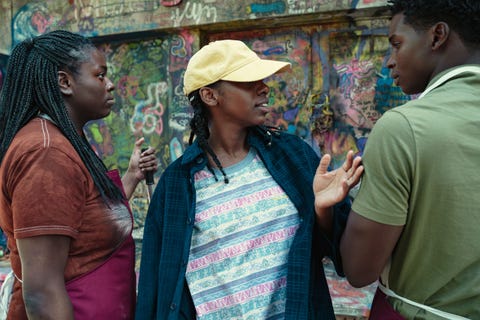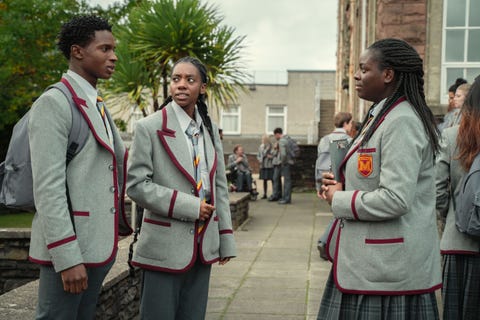Dua Saleh is an activist, writer, and artist known for turning their poetry into lush lyricism that tackles issues like systemic racism and LGBTQ+ rights. Lucky for us, that creativity is now consumable in another medium: Saleh has made their first foray into acting as Cal in season 3 of Netflix’s teen dramedy Sex Education.
The U.K. series follows Moordale High student Otis (Asa Butterfield), who runs an underground sex therapy practice on campus inspired by his actual sex therapist mother Jean (Gillian Anderson). While Otis and Jean are at the heart of the show’s premise, it’s really the cast of surrounding high school misfits, teachers, and quirky parents that make Sex Education one of the most addicting, authentic, and inclusive shows on television.
Saleh’s Cal is a free-spirit skater who goes to bat with Moordale’s new headmistress Hope (Jemima Kirke) after being forced to wear a school uniform for girls. Like their character, Saleh is nonbinary. Also like their character, Saleh is intimately familiar with the frustrations that come from living in a world trying to box you in. It’s what cemented Saleh’s interest in playing the character after reading the script. “Cal is not one-dimensional, Cal is somebody that has depth and texture—someone who is layered, who has complexities,” Saleh tells ELLE.com. “I was honestly brought to tears at times on set.”
Below, the multi-hyphenate talks harnessing their personal experiences to play Cal, the impactful role fashion plays in the series, and and how Sex Education inspired their new EP, Crossover.
Sex Education marks your acting debut. What was it like being on set for the first time?
All of the producers made me feel comfortable, like making sure people knew my pronouns before I got on set. All the cast members were really welcoming and warm and sweet to me, too. Jemima Kirke was really funny. She’s a Taurus, and I’m a Scorpio, so I found that we really got along. It was nice to have somebody I could really connect with.
That’s funny especially considering how much you two clash in the show.
I’m not going to lie, my scenes with her were really difficult. At times I was scared going in, because I knew that her acting was going to be so good. The scene that got to me the most was when Hope pushed Cal into that room, which we had to redo over and over again. There’s also the scene where Hope “chains” Adam, Lily, and Cal on a stage. That was difficult for me to process, because there were supporting artists in the audience, so it felt like we were actually being laughed at.
It’s a moment earlier on in the season, but I love when Cal confronts Hope about the dress code.
It’s beautiful that Cal is so forthright about their subversion of gender depression. It felt amazing to have that narrative put in there, because I know for a lot of trans and nonbinary people, dysphoria is something that’s a huge part of their everyday life. Oftentimes, that comes into play with clothing. Cal felt gender euphoria by wearing pants and a tie, and a suit and baggy clothing. It was really beautiful that they were impacted enough to just be honest and say, “I don’t want to wear this” and “I’m not going to wear a skirt.”
This content is imported from Instagram. You may be able to find the same content in another format, or you may be able to find more information, at their web site.
Was your time in high school at all similar to Cal’s experience?
In high school I was more of an uptight student. I went to classes and did after school programs and organizing work and urban planning with the city of St. Paul, so I was not really worried about how I dressed. I dressed really nerdy and kind of weird, because I shopped at thrift shops a lot. I grew up low-income. People would sometimes comment on the randomness of the clothes I wore. I gravitated towards a lot of different types of clothing, but one outfit that sticks in my mind is a flannel shirt with a long, tight floral skirt. People were like, “I like this. I wouldn’t ever wear it, but I like this.” That’s different from how I am now. As I got older, I learned more about gender non-conformity and about the term nonbinary and Indigenous gender expressions. So I started dressing in looser-fitted clothing. I started experimenting with makeup in ways that separate expectations of what people understand about people who are assigned female at birth. I’m probably more like Cal in my adulthood than I was when I was younger. We don’t necessarily dress exactly alike, but I wear a binder and most of the clothing that I buy is from quote, unquote, the “men’s department.”
What were some of your favorites scenes to film?
There is a moment after Layla [Robyn Holdaway] felt affirmed by Cal, when Cal brings Layla a binder. A couple of people had DM’d me saying how important it was to have a nonbinary character come onto the show, and I just started crying. I was probably emotional in general, because doing the show was such a huge shift in my life, but seeing those messages and having a scene with another trans person about transness in a way that’s telling trans people to take care of themselves and not harm themselves with binding, it’s just…I’m getting emotional right now just talking about it.
That moment felt so authentic.
I studied gender and sexuality studies and sociology in college. So I know there really isn’t anything like that scene anywhere else in pop culture.
One thing I felt was really important to emphasize was the narrative around Cal’s queerness, or having a discussion about Cal’s sexuality in general, because I thought that would be important for a lot of nonbinary people to hear—especially people who’ve had to have conversations with cisgender partners.
This content is imported from Instagram. You may be able to find the same content in another format, or you may be able to find more information, at their web site.
Speaking of, what’s your take on Cal’s relationship with Jackson?
You can see the sparks initially, when they had their first meet-cute. You can tell that they have an instant spark, maybe a spiritual spark, like a twin flame kind of thing. But I think it’s beautiful that they were able to be vulnerable with each other and confide in each other and also be loving enough to be honest and forthright about what they both want and how they both feel in their romantic dynamic.
Cal reinforces the fact that they are nonbinary and not a girl, and places importance on how their prospective love interest would perceive them and how they would operate in that dynamic. Jackson is like, “Oh, I need to work on that. So I don’t think it would be right for us to try to continue with this when we’re at two different places mentally in relationship to gender and sexuality.” When Kedar [Williams-Stirling, who plays Jackson] and I rehearsed before takes, our main focus was on trying to get a feel for the tone before we went into a scene. We talked through certain things, either just with each other, or with the intimacy coordinator.
What was the process of intimacy coordination like on set?
Having an intimacy coordinator was good for me for many different reasons, one being that I’m Sudanese. We really value our privacy. So our intimacy coordinator would make sure to close down the set and have as few people there as possible. He also warmed us up before scenes that I felt particularly anxious about. We would do icebreakers and funny little games to make us feel more comfortable. We did consent activities, asking where is okay to touch and what’s comfortable.
This content is imported from Instagram. You may be able to find the same content in another format, or you may be able to find more information, at their web site.
Your new EP, Crossover, comes out September 24. How did you balance filming Sex Education and making music?
I had a home studio, and was trying to make as much music as I could, but honestly the filming schedule was so overwhelming that I didn’t have much time to work on it. I released one song called “Signs” while I was working on the show, but a lot of the other songs I worked on didn’t end up being released. I did work on some songs that will be on Crossover, which is about the different transitions I’m experiencing right now—one being my move into the mainstream with Sex Education, and the hyper-visibility that comes with that. For me, crossover also refers to the kind of music I’m making. I’ve been described as genre-bending in the past, and on this EP, I fuse a lot of different Afro-diasphoric sounds and trans-dialectical pop, influenced by artists like SOPHIE, who invented hyper-pop. The other crossover that I’m experiencing is with my transness—that’s ever-going. I feel like I’m making it sound more serious than it actually is. Honestly, it’s just a lot of party songs, because I feel like people have been in a lot of darkness because of the pandemic and I want people to have something to vibe and dance to, and to feel good about.
This interview has been edited and condensed for clarity.
This content is created and maintained by a third party, and imported onto this page to help users provide their email addresses. You may be able to find more information about this and similar content at piano.io


